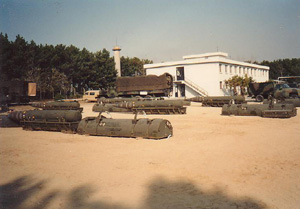Actual deployments began in January 1958, four
and a half years after the end of the Korean War, with
the introduction of five nuclear weapon systems: the Honest John
surface-to-surface missile, the Matador cruise missile, the
Atomic-Demolition Munition (ADM) nuclear landmine, and the 280-mm gun
and 8-inch (203mm) howitzer.
 |
|
The Davy Crockett projectile was deployed in
South Korea between July 1962 and June 1968. The warhead had
selective yields up to 0.25 kilotons. The projectile weighed
only 34.5 kg (76 lbs). |
Nuclear bombs for fighter bombers arrived in March 1958, followed by
three surface-to-surface missile systems (Lacrosse, Davy Crockett, and
Sergeant) between July 1960 and September 1963. The dual-mission Nike
Hercules anti-air and surface-to-surface missile arrived in January
1961, and finally the 155-mm Howitzer arrived in October 1964. At the
peak of this build-up, nearly 950 warheads were deployed in South Korea.
Four of the weapon types only remained deployed for a few years,
while the others stayed for decades. The 8-inch Howitzer stayed until late 1991, the only of the
weapon to be deployed throughout the entire 33-year period of U.S.
nuclear weapons deployment to South Korea. The other weapons that stayed
till the end were the air delivered bombs (several different bomb types
were deployed over the years, ending with the B61) and the 155-mm
Howitzer nuclear artillery.
The nuclear bombs served both a strategic (SIOP) and non-strategic
(theater) role. In 1974,
according to Pacific Command, four F-4D Phantom jets of the 8th
Tactical Fighter Wing (TFW) at Kunsan Air Base were parked at the end of
the runway with nuclear bombs under their wings as U.S. Pacific Air
Forces' SIOP Quick Reaction Alert commitment. Their targets were
probably in China, only 390 km to the west. The 8th TFW also had a
non-SIOP role, presumably against targets in North Korea.
|
The China
SIOP Axis |
|
Kunsan AB |
Kadena AB |
Clark AB |
|
8 TFW |
18
TFW |
3 TFW |
|
Three U.S. tactical fighter wings in South Korea,
Japan, and the Philippines formed a SIOP strike axis against
China in 1974. |
Kunsan's SIOP strike role in 1974 formed part of a three-base axis
off China together with the 18th Tactical Fighter Wing at Kadena Air
Base in Okinawa and the 3rd Tactical Fighter Wing at Clark Air Base in
the Philippines. Although only Kunsan had a Quick Reaction Alert role at
the time, all three bases had a "major SIOP non-alert role,"
according to Pacific Command. The 18th TFW SIOP non-alert role is
noteworthy because it shows that the United States continued nuclear
strike operations from Okinawa after the island was returned to
Japanese control and nuclear weapons removed in June 1972. The continued
SIOP role at Kadena means that a diplomatic arrangement (agreement)
likely existed between the U.S. and Japan for the reintroduction of
nuclear bombs to Kadena Air Base in a crisis.
The Lance surface-to-surface missile
was also deployed to South Korea but apparently
only with conventional warheads. The nuclear warheads were stored in
Guam, where the last of 54 W70 warheads arrived at the Naval Magazine on
September 30, 1976.
The internal discussions about Lance provide an interesting example
of the trade-off between different weapon capabilities. The
army recommended deploying Lance to South Korea because of "Korea as
the most likely area requiring use of ground nuclear weapons," and
because building extra storage on Guam would be expensive.
CINCPAC agreed but recommended that the aging Honest John and Nike
Hercules systems be withdrawn upon introduction of Lance. The Commander
of U.S. Force Korea concurred but
stated that it would be unacceptable to withdraw the Nike Hercules
because of its unique anti-air capability.
The Joint Chiefs of Staff were concerned that deployment to the
Pacific would be delayed by the presidential decision process on whether
to also deploy Lance in South Korea, so the Lance warheads were rushed
to Guam. By the end of December 1976, according to the
U.S. Pacific Command history, all authorized warheads were
in place on Guam.
 |
|
The Lance surface-to-surface missile was deployed
to South Korea, but only in a conventional version. The nuclear
warheads stranded in Guam. |
The Lance deployment coincided with
a major review of the security of nuclear weapons
storage sites in the Pacific. The review, which also examined diplomatic
arrangements for storage in allied countries and the requirements for
nuclear weapons in the region, found that security was unsatisfactory,
that diplomatic arrangements were inadequate, and that the number of
weapons deployed exceed the requirements of the war plans.
As a result, the FY 1977 nuclear weapons deployment plan trimmed the
posture, which included removing 140 nuclear weapons from the Philippines, and
initiated the
withdrawal of the Honest John, Nike Hercules, and Sergeant missile
systems from South Korea. In mid-1977,
according to CINCPAC, nuclear weapons in South Korea were stored at
Camp Ames, Kunsan Air Base, and Osan Air Base. The nuclear weapons
storage site at Osan Air base was deactivated in late 1977. This
reduction continued over the following years and resulted in the number of nuclear weapons in
South Korea dropping from
some 540 in 1976 to approximately 150 artillery shells and bombs in
1985. By the time of the Presidential Nuclear Initiative in 1991,
roughly 100 warheads remained, all of which had been withdrawn by
December 1991.
See
also the other Korea sections:
»
The withdrawal of U.S. nuclear weapons from South Korea
»
U.S. nuclear strike planning against North Korea

